| Article ID | Journal | Published Year | Pages | File Type |
|---|---|---|---|---|
| 6888634 | Pervasive and Mobile Computing | 2018 | 20 Pages |
Abstract
As a key component of building management and security, occupancy inference through smart sensing has attracted a lot of research attention for nearly two decades. Nevertheless, existing solutions mostly rely on either pre-deployed infrastructures or user device participation, thus hampering their wide adoption. This paper presents CeilingSee, a dedicated occupancy inference system free of heavy infrastructure deployments and user involvements. Building upon existing LED lighting systems, CeilingSee converts part of the ceiling-mounted LED luminaires to act as sensors, sensing the variances in diffuse reflection caused by occupants. In realizing CeilingSee, we first re-design the LED driver to leverage LED's photoelectric effect so as to transform a light emitter to a light sensor. In order to produce accurate occupancy inference, we then engineer efficient learning algorithms to fuse sensing information gathered by multiple LED luminaires. We build a testbed covering a 30Â m2 office area; extensive experiments show that CeilingSee is able to achieve very high accuracy in occupancy inference.
Keywords
Related Topics
Physical Sciences and Engineering
Computer Science
Computer Networks and Communications
Authors
Yanbing Yang, Jun Luo, Jie Hao, Sinno Jialin Pan,
